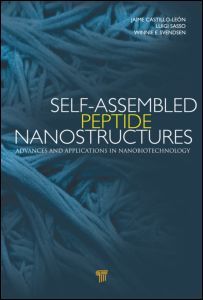Description
Self-Assembled Peptide Nanostructures
Advances and Applications in Nanobiotechnology
Coordinators: Castillo Jaime, Sasso Luigi, Svendsen Winnie Edith
Language: English
Subjects for Self-Assembled Peptide Nanostructures:
Keywords
Self-assembling Peptide; Peptide Nanotubes; Theoretical basis of biological self-assembly; PAs; Peptide-based materials via molecular self-assembly; Peptide Nanostructures; Manipulation of self-assembled peptide nanostructures; Te Ra Ct Io; Applications in bionanotechnology of self-assembled peptide nanostructures; American Chemical Society; Self-assembling peptides as a new class of medical device for regenerative medicine; Tissue Engineering; Peptide Building Blocks; Hydrogen Bonds; Peptide Structures; Glucose Oxidase; Cell Culture; Cyclic Peptides; SPPS; Color Insert; Peptide Primary Structure; CLSM Image; Dynamic Covalent Chemistry; AFM Tip; Peptide Hydrogels; Lipid Bilayer Membrane; NIRF; Bone Tissue Engineering; Hydrogen Bonding Pattern; Hollow Nanotubes
Support: Print on demand
Description
/li>Contents
/li>Biography
/li>
The self-organization of bionanostructures into well-defined functional machineries found in nature has been a priceless source of ideas for researchers. The molecules of life, proteins, DNA, RNA, etc., as well as the structures and forms that these molecules assume serve as rich sources of ideas for scientists or engineers who are interested in developing bio-inspired materials for innovations in biomedical fields. In nature, molecular self-assembly is a process by which complex three-dimensional structures with well-defined functions are constructed, starting from simple building blocks such as proteins and peptides.
This book introduces readers to the theory and mechanisms of peptide self-assembly processes. The authors present the more common peptide self-assembled building blocks and discuss how researchers from different fields can apply self-assembling principles to bionanotechnology applications. The advantages and challenges are mentioned together with examples that reflect the state of the art of the use of self-assembled peptide building blocks in nanotechnology.
Theoretical basis of biological self-assembly. Natural and designed self-assembling peptides and their applications in bionanotechnology. Peptide-based materials via molecular self-assembly. Self-assembling peptide nanostructures: towards bioactive artificial protein nanomaterials. Manipulation of self-assembled peptide nanostructures. Applications in bionanotechnology of self-assembled peptide nanostructures. Biomedical applications of assembled peptide and protein micro- or nanostructures. Self-assembling peptides as a new class of medical device for regenerative medicine.
Jaime Castillo-León graduated from the Industrial University of Santander (Bucaramanga, Colombia) with a BSc in chemistry. He received his doctorate in 2005 from the Department of Biotechnology at Lund University. His thesis involved the fabrication of electrochemical biosensors for the detection of compounds of biomedical importance using cellular models. Currently, he is assistant professor in the Department of Micro and Nanotechnology, DTU Nanotech at the Technical University of Denmark. His research focuses on micro- and nanotechnologies for the development of biosensing devices for biomedical applications. A strong focus is in the manipulation, characterization, and integration of biological nanotubes and nanofibers with micro- and nanostructures for the development of bioelectronic sensing devices and drug delivery systems.
Luigi Sasso graduated from the University of Illinois at Chicago with a BSc (Honors) in chemical engineering. He received an international master’s degree in physics and nanotechnology from the Technical University of Denmark in 2009. Currently, he is pursuing his doctorate at the Nano-Bio Integrated Systems group (NaBIS), while working with surface modifications of nanoelectrodes for cellular measurements. His research involves the use of new biosensor materials, with a focus on self-assembled peptide nanostructures.
Winnie Edith Svendsen received her master’s degree in physics from University College Dublin, Ireland, in 1993, where she received the EOLAS applied research award for excellent research. She obtained her PhD from Copenhagen University and RISØ in 1996. She then accepted a postdoctoral position at the Max Planck Institute for Plasma Physics, Germany. In 1998, Dr Svendsen received a talent stipend from SNF (now FNU) and the prestigious Curie stipend from Copenhagen University to establish a research group to design a hyperpolarized gas setup for use in medical lung diagnostics. In connection wit
These books may interest you

Introduction to Peptide Science 65.19 €



